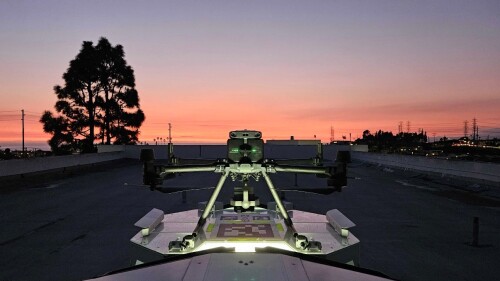By Police1 Staff
The future of public safety is airborne. In a recent webinar titled “The future of rapid response with drones as first responders,” Flock Safety CEO Garrett Langley and VP of Aviation Rahul Sidhu revealed how drones as first responders (DFR) are reshaping law enforcement by providing faster, safer and more cost-effective ways to handle emergencies. This cutting-edge technology is particularly valuable in a time when agencies are grappling with staffing shortages and increasing demands on resources.
“It’s abundantly clear that the future is in the air,” said Langley. “When you look at Flock’s overall product strategy, we’ve been thinking about how to help communities be safer and respond to incidents faster for almost seven years. Drones as first responders are the next logical step.”
This vision has been bolstered by Flock Safety’s recent acquisition of Aerodome, a company at the forefront of drone innovation for public safety. The acquisition enables Flock to offer a fully integrated system combining Aerodome’s advanced drone technology with Flock’s ecosystem of real-time data and AI tools.
A new era in law enforcement response
For law enforcement, responding quickly to emergencies often means the difference between life and death. However, traditional methods like patrol cars or helicopters can be limited by traffic, costs and availability. Enter DFR technology, which offers an agile, scalable solution.
The concept of drones as first responders isn’t entirely new, but the evolution of the technology has been transformative. In the webinar, Sidhu reflected on the origins of DFR, starting with the pioneering efforts in Chula Vista, California, back in 2018. Since then, the integration of drones with real-time crime centers has brought a new level of efficiency to law enforcement.
“Traditional air support has its limitations,” Sidhu explained. “Helicopters can be expensive, they can draw community concerns with things like noise and environmental impact, and they’re not always available.” He added, “What I’m going to talk about today isn’t designed simply to replace traditional air support but to supplement it in a way that provides additional benefits.”
Drones equipped with high-definition cameras, night vision and thermal imaging are now capable of reaching incident scenes in less than 90 seconds. This rapid deployment not only provides situational awareness to officers but can also clear calls without requiring ground units, saving precious time and resources.
“We’ve seen drones reduce officer response times by up to 80%,” Langley said, “and this not only saves time but also improves officer safety and efficiency.”
One notable example is Elk Grove PD in California, which has integrated DFR into its operations. By using drones to clear 20% of calls without deploying officers, the department has freed up resources for higher-priority incidents while improving response times.
“With Flock and Aerodome, Elk Grove PD has shown how integrating drones with real-time crime centers can transform operations,” Langley noted. “This isn’t just a success story; it’s a model for how other agencies can innovate.”
From challenges to innovation
The road to widespread DFR adoption hasn’t been without challenges. One of the biggest hurdles has been navigating FAA regulations, particularly regarding beyond visual line of sight (BVLOS) operations.
“The regulatory environment has shifted,” Langley explained. “The FAA is now more open to public safety use cases, allowing agencies to use drones in ways that weren’t possible a few years ago.”
Technological advancements have also played a crucial role in overcoming barriers. Automated battery-swapping docks ensure drones can operate continuously, while seamless integration with Flock OS enables real-time data sharing across systems.
“Imagine receiving an ALPR hit for a stolen vehicle,” Sidhu illustrated. “Instead of waiting for an officer to fight through traffic, you launch a drone that can track the vehicle in real time, providing updates until ground units arrive. That’s the power of this technology.”
Drones also address operational challenges like staffing shortages. “We work in an environment where it’s harder to hire cops, and that means patrol shortages,” Sidhu noted. “DFR helps agencies optimize their resources and respond to calls more effectively.”
Building community trust
Beyond operational improvements, DFR technology has proven to be a valuable tool for fostering community trust. Agencies like Elk Grove PD have embraced transparency by creating public-facing dashboards that share data on drone deployments and their outcomes.
“Transparency is critical,” Sidhu emphasized. “We’ve designed drones to minimize noise and ensure they operate in a way that respects community concerns. At 400 feet, drones are quieter and less noticeable while still delivering critical intelligence.”
Flying drones at higher altitudes not only reduces noise but also provides a broader field of view, enhancing their effectiveness while addressing common public concerns.
“This is the next generation of policing. Every agency deserves access to the tools that make communities safer.”
What’s next for DFR?
Flock Safety’s vision for the future of DFR includes integrating AI to predict crime patterns, deploying fixed-wing drones for longer missions, and enhancing real-time collaboration between agencies.
“We’re just scratching the surface of what’s possible,” Langley said. “As technology advances, we’ll continue to push the boundaries of how drones can support public safety.”
To agencies considering DFR, Sidhu offered this advice: “Start by identifying your pain points. Whether it’s response times, officer safety, or resource allocation, DFR can be tailored to meet your needs.”
Conclusion: A safer, faster future
As the webinar demonstrated, drones as first responders are more than just a technological innovation—they’re a transformative tool for public safety. By providing rapid situational awareness, improving officer efficiency, and fostering community trust, DFR is setting a new standard for law enforcement.
“This is the next generation of policing,” Langley concluded. “Every agency deserves access to the tools that make communities safer.”




